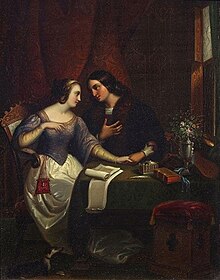|
Letters of Abelard and Heloise
The Letters of Abelard and Heloise are a series of passionate and intellectual correspondences written in Latin during the 12th century. The authors, Peter Abelard, a prominent theologian, and his pupil, Heloise, a gifted young woman later renowned as an abbess, exchanged these letters following their ill-fated love affair and subsequent monastic lives. The letters reveal the personal and intellectual relationship between Abelard and Heloise, and provide an intimate glimpse into the societal context of 12th-century Europe. They've played a significant role in the development of Western epistolary literature, attracting attention from historians, literary scholars, and general readers alike. The Letters of Abelard and Heloise also serve as primary source documents on questions of medieval gender roles, love, and monastic life. Publication history   The story of Abelard and Héloïse has proved immensely popular in modern European culture. This story is known almost entirely from a few sources: first, the Historia Calamitatum; secondly, the seven letters between Abelard and Héloïse which survive (three written by Abelard, and four by Héloïse), and always follow the Historia Calamitatum in the manuscript tradition; thirdly, four letters between Peter the Venerable and Héloïse (three by Peter, one by Héloïse).[1] They are, in modern times, the best known and most widely translated parts of Abelard's work. Early indicationsIt is unclear quite how the letters of Abelard and Héloïse came to be preserved. There are brief and factual references to their relationship by 12th-century writers including William Godel and Walter Map. While the letters were most likely exchanged by horsemen in a public (open letter) fashion readable by others at stops along the way (and thus explaining Heloise's interception of the Historia), it seems unlikely that the letters were widely known outside of their original travel range during the period. Rather, the earliest manuscripts of the letters are dated to the late 13th century. It therefore seems likely that the letters sent between Abelard and Héloïse were kept by Héloïse at the Paraclete along with the 'Letters of Direction', and that more than a century after her death they were brought to Paris and copied.[2] Shortly after the deaths of Abelard and Heloise, Chrétien de Troyes appears influenced by Heloise's letters and Abelard's castration in his depiction of the fisher king in his grail tales.[3] In the fourteenth century, the story of their love affair was summarised by Jean de Meun in the Le Roman de la Rose. Chaucer makes a brief reference in the Wife of Bath's Prologue (lines 677–8) and may base his character of the wife partially on Heloise. Petrarch owned an early 14th-century manuscript of the couple's letters (and wrote detailed approving notes in the margins). First known publicationsThe first Latin publication of the letters was in Paris in 1616, simultaneously in two editions. These editions gave rise to numerous translations of the letters into European languages – and consequent 18th- and 19th-century interest in the story of the medieval lovers.[4] In the 18th century, the couple were revered as tragic lovers, who endured adversity in life but were united in death. With this reputation, they were the only individuals from the pre-Revolutionary period whose remains were given a place of honour at the newly founded cemetery of Père Lachaise in Paris. At this time, they were effectively revered as romantic saints; for some, they were forerunners of modernity, at odds with the ecclesiastical and monastic structures of their day and to be celebrated more for rejecting the traditions of the past than for any particular intellectual achievement.[5] The Historia was first published in 1841 by John Caspar Orelli of Turici. Then, in 1849, Victor Cousin published Petri Abaelardi opera, in part based on the two Paris editions of 1616 but also based on the reading of four manuscripts; this became the standard edition of the letters.[6] Soon after, in 1855, Migne printed an expanded version of the 1616 edition under the title Opera Petri Abaelardi, without the name of Héloïse on the title page. Critical editions and authenticityCritical editions of the Historia Calamitatum and the letters were subsequently published in the 1950s and 1960s. The most well-established documents, and correspondingly those whose authenticity has been disputed the longest, are the series of letters that begin with the Historia Calamitatum (counted as letter 1) and encompass four "personal letters" (numbered 2–5) and "letters of direction" (numbers 6–8). Most scholars today accept these works as having been written by Héloïse and Abelard themselves. John Benton is the most prominent modern skeptic of these documents. Etienne Gilson, Peter Dronke, Constant Mews, and Mary Ellen Waithe maintain the mainstream view that the letters are genuine, arguing that the skeptical viewpoint is fueled in large part by its advocates' pre-conceived notions.[7] Additional love lettersMore recently, it has been argued that an anonymous series of letters, the Epistolae Duorum Amantium,[8] were in fact written by Héloïse and Abelard during their initial romance (and, thus, before the later and more broadly known series of letters). This argument has been advanced by Constant J. Mews,[9] based on earlier work by Ewad Könsgen.[10] If genuine, these letters represent a significant expansion to the corpus of surviving writing by Héloïse, and thus open several new directions for further scholarship. However, because the second set of letters is anonymous, and attribution "is of necessity based on circumstantial rather than on absolute evidence," their authorship is still a subject of debate and discussion.[11] Recently, Rüdiger Schnell has argued that a close reading reveals the letters as parody, ridiculing their supposed authors by characterizing the male writer as boastful and macho, while simultaneously humiliating himself in pursuit of his correspondent, and the female writer, ostensibly an exemplar of ideal love, as a seeker of sexual pleasure under the cover of religious vocabulary.[12] References
|